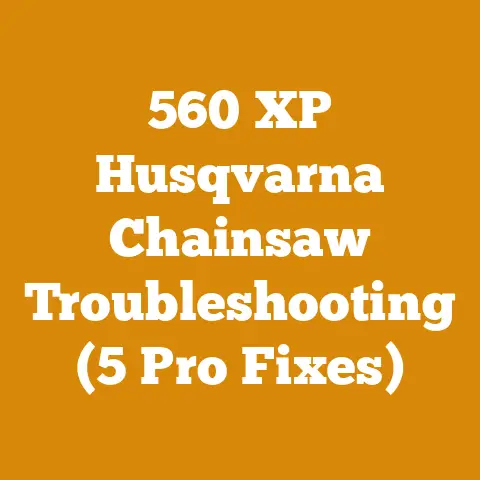Oregon Chainsaw Bar Compatibility Chart (7 Expert Tips)
Have you ever stared at your chainsaw, then at a replacement Oregon chainsaw bar, feeling like you’re trying to solve a Rubik’s Cube blindfolded? I know I have. Countless times, actually. One wrong move, and you’re not cutting wood – you’re cutting into your precious time and wallet. This isn’t just about slapping on any old bar; it’s about finding the right bar that makes your chainsaw sing.
Choosing the correct chainsaw bar can be daunting. It’s more than just picking one that “looks” right. You need to consider your chainsaw model, the type of cutting you’ll be doing, and the specific features of the bar itself. Get it wrong, and you risk damaging your saw, reducing its efficiency, or even facing a safety hazard.
That’s why I’ve put together this guide to understanding the Oregon chainsaw bar compatibility chart, along with seven expert tips to help you make the right choice. Think of this as your cheat sheet to chainsaw bar compatibility. I’m going to break down the jargon, share some hard-earned wisdom, and guide you through the process of selecting the perfect bar for your needs.
Decoding the Oregon Chainsaw Bar Compatibility Chart
The Oregon chainsaw bar compatibility chart is your first port of call when you’re looking for a new bar. It’s a treasure trove of information, but it can be overwhelming if you don’t know how to read it.
Understanding the Chart’s Structure
The chart is typically organized by chainsaw manufacturer and model. You’ll find columns listing various bar lengths, chain pitches, gauge, and drive link counts. It might look like a jumble of numbers and letters, but each element plays a crucial role in ensuring compatibility.
- Manufacturer & Model: This is where you find your specific chainsaw. Make sure you double-check the model number – even slight variations can affect bar compatibility.
- Bar Length: Measured in inches, this refers to the usable cutting length of the bar. Choose a length appropriate for the size of the wood you’ll be cutting.
- Chain Pitch: The distance between any three consecutive rivets on the chain, divided by two. Common pitches are .325″, 3/8″, and .404″.
- Gauge: The thickness of the drive links that fit into the bar groove. Common gauges are .050″, .058″, and .063″.
- Drive Link Count: The number of drive links on the chain. This must match the bar’s specifications for proper chain fit.
How to Use the Chart Effectively
- Identify Your Chainsaw Model: Start by finding your chainsaw’s manufacturer and exact model number. This information is usually found on a sticker or plate on the saw body.
- Locate Recommended Bar Lengths: The chart will list the recommended bar lengths for your model. Pay attention to any notes or restrictions.
- Note the Chain Pitch and Gauge: These are critical for chain compatibility. Using the wrong pitch or gauge can damage your saw and create a safety hazard.
- Confirm the Drive Link Count: This number must match the number of drive links on your chain. Count them carefully!
- Cross-Reference with Oregon’s Website: Always double-check the information on the chart with the official Oregon website. Compatibility data can change, so it’s best to have the most up-to-date information.
Real-World Example
Let’s say you have a Stihl MS 271 chainsaw. Looking at the Oregon chart, you might find that it recommends bar lengths of 16″ or 18″ with a chain pitch of .325″ and a gauge of .063″. The drive link count will vary depending on the bar length (e.g., 62 drive links for a 16″ bar).
This information tells you that you need to choose an Oregon bar that matches these specifications to ensure proper fit and performance on your Stihl MS 271.
7 Expert Tips for Choosing the Right Oregon Chainsaw Bar
Now that you understand the basics of the compatibility chart, let’s dive into some expert tips that will help you make the best possible choice.
Tip #1: Consider Your Cutting Needs
The type of cutting you’ll be doing should heavily influence your bar selection. Are you primarily felling large trees, limbing branches, or cutting firewood?
- Felling Large Trees: Requires longer bars (18″ or more) for reaching through thick trunks. Look for durable bars with replaceable sprockets.
- Limbing Branches: Shorter bars (12″ to 16″) offer better maneuverability and control. Lightweight bars are ideal for reducing fatigue.
- Cutting Firewood: Mid-length bars (16″ to 18″) strike a balance between cutting capacity and ease of use. Consider bars with features like Lubri-Dam to improve oiling.
Personal Story: I once tried to fell a large oak tree with a 14″ bar. It was a frustrating and inefficient experience. I ended up having to make multiple cuts, wasting time and energy. That’s when I learned the importance of matching bar length to the task at hand.
Tip #2: Understand Bar Types and Features
Oregon offers a variety of bar types, each with its own strengths and weaknesses.
- Laminated Bars: These are the most common type, consisting of multiple layers of steel welded together. They’re affordable and suitable for general use.
- Solid Bars: Made from a single piece of steel, solid bars are more durable and resistant to bending. They’re often preferred for heavy-duty applications.
- Sprocket Nose Bars: These bars have a sprocket at the tip, which reduces friction and improves cutting speed. They’re a good choice for felling and bucking.
- Hard Nose Bars: These bars have a hardened tip for increased wear resistance. They’re ideal for abrasive conditions, such as cutting dirty or sandy wood.
Data Point: Sprocket nose bars can increase cutting speed by up to 15% compared to hard nose bars, according to Oregon’s internal testing.
Tip #3: Match Bar Length to Engine Size
As a general rule, larger engines can handle longer bars. Using a bar that’s too long for your engine can strain the saw and reduce its performance.
- Small Engines (30-40cc): Typically suited for bars up to 16″.
- Mid-Size Engines (40-50cc): Can handle bars up to 18″.
- Large Engines (50cc+): Can accommodate bars of 20″ or longer.
Caution: Always consult your chainsaw’s owner’s manual for the manufacturer’s recommended bar lengths.
Tip #4: Pay Attention to Oiling
Proper lubrication is essential for extending the life of your bar and chain. Look for bars with features that enhance oiling.
- Lubri-Dam: Oregon’s Lubri-Dam feature helps retain oil on the bar, reducing wear and improving cutting performance.
- Oil Holes: Ensure that the oil holes on the bar align with the oil outlet on your chainsaw.
- Regular Cleaning: Clean the bar groove and oil holes regularly to prevent clogging.
Insight: I’ve found that using a high-quality bar and chain oil makes a significant difference in the longevity of my cutting equipment. It’s worth investing in a good oil to protect your investment.
Tip #5: Consider Bar Weight
Bar weight can have a significant impact on your comfort and fatigue levels, especially during extended use.
- Lightweight Bars: Ideal for limbing and pruning, where maneuverability is key.
- Standard Bars: Suitable for general-purpose cutting.
- Heavy-Duty Bars: Designed for felling large trees and other demanding tasks.
Tip: If you’re using a chainsaw for long periods, consider using a bar suspension system to reduce strain on your arms and back.
Tip #6: Check for Compatibility with Your Chain
This might seem obvious, but it’s crucial to ensure that the bar you choose is compatible with your existing chain. The bar’s pitch and gauge must match the chain’s specifications.
- Chain Pitch: The distance between any three consecutive rivets on the chain, divided by two.
- Gauge: The thickness of the drive links that fit into the bar groove.
Warning: Using an incompatible chain can damage the bar, chain, and chainsaw, and it can also create a safety hazard.
Tip #7: Buy From a Reputable Source
When purchasing an Oregon chainsaw bar, it’s important to buy from a reputable dealer or retailer. This will ensure that you’re getting a genuine product and that you have access to customer support if needed.
- Authorized Dealers: Oregon has a network of authorized dealers who can provide expert advice and support.
- Online Retailers: If buying online, choose a reputable retailer with a good return policy.
- Avoid Counterfeit Products: Be wary of suspiciously low prices, as these may indicate counterfeit products.
Wood Anatomy and Properties: Understanding Your Cutting Material
Choosing the right chainsaw bar isn’t just about the tool itself; it’s also about understanding the material you’re cutting. Wood anatomy and properties play a significant role in determining the best bar for the job.
Hardwood vs. Softwood
The terms “hardwood” and “softwood” refer to the type of tree from which the wood originates, not necessarily the actual hardness of the wood.
- Hardwoods: Typically deciduous trees with broad leaves (e.g., oak, maple, cherry). They’re generally denser and more difficult to cut than softwoods.
- Softwoods: Typically coniferous trees with needles (e.g., pine, fir, spruce). They’re generally less dense and easier to cut than hardwoods.
Data Point: Oak, a common hardwood, has a Janka hardness rating of around 1,300 lbf, while pine, a common softwood, has a Janka hardness rating of around 380 lbf.
Grain Direction
The direction of the wood grain can affect how easily it cuts.
- Cutting with the Grain: Easier and faster, as the chainsaw follows the natural fibers of the wood.
- Cutting Against the Grain: More difficult and slower, as the chainsaw has to sever the wood fibers.
Tip: When cutting against the grain, use a sharp chain and apply consistent pressure to avoid kickback.
Moisture Content
The moisture content of wood can significantly affect its cutting properties.
- Green Wood: Wood that has recently been cut and has a high moisture content. It’s generally easier to cut than dry wood but can be heavier and more prone to binding.
- Dry Wood: Wood that has been seasoned and has a low moisture content. It’s generally harder to cut than green wood but is lighter and less prone to binding.
Data Point: Green wood can have a moisture content of 100% or more, while seasoned firewood typically has a moisture content of 20% or less.
Knots and Defects
Knots and other defects in the wood can make cutting more difficult and increase the risk of kickback.
- Knots: Hard, dense areas where branches grew from the tree. They can deflect the chainsaw and cause it to bind.
- Defects: Include cracks, splits, and decay. These can weaken the wood and make it more unpredictable to cut.
Safety Tip: When cutting wood with knots or defects, use extra caution and maintain a firm grip on the chainsaw.
Logging Tool Selection and Maintenance Best Practices
Your chainsaw bar is just one piece of the puzzle. To be a truly effective wood processor, you need to select the right logging tools and maintain them properly.
Essential Logging Tools
- Chainsaw: The primary tool for felling, bucking, and limbing trees.
- Axe: Useful for splitting small logs and wedges.
- Wedges: Used to prevent the saw from binding during felling.
- Felling Lever: Provides leverage to help push over trees in a specific direction.
- Cant Hook/Peavey: Used to roll and position logs for bucking.
- Measuring Tape: Essential for accurate bucking of firewood.
- Safety Gear: Includes a helmet, eye protection, hearing protection, gloves, and chaps.
Chainsaw Maintenance
- Sharpening: Keep your chain sharp for efficient cutting and reduced kickback.
- Cleaning: Regularly clean the bar groove, oil holes, and air filter.
- Lubrication: Use a high-quality bar and chain oil to keep the bar and chain properly lubricated.
- Inspection: Inspect the bar, chain, and chainsaw for wear and damage before each use.
- Storage: Store your chainsaw in a dry, safe place when not in use.
Axe Maintenance
- Sharpening: Keep your axe sharp for efficient splitting.
- Handle Care: Protect the handle from moisture and damage.
- Storage: Store your axe in a dry, safe place when not in use.
General Tool Safety
- Read the Manuals: Familiarize yourself with the operating instructions and safety precautions for each tool.
- Wear Safety Gear: Always wear appropriate safety gear when working with logging tools.
- Work in a Safe Area: Clear the area of obstacles and ensure that you have enough space to work safely.
- Stay Alert: Pay attention to your surroundings and avoid distractions.
- Know Your Limits: Don’t attempt to lift or move logs that are too heavy for you.
Firewood Seasoning Techniques and Safety Considerations
Once you’ve cut your wood, you need to season it properly before burning it in your fireplace or wood stove. Seasoning reduces the moisture content of the wood, making it burn more efficiently and cleanly.
Seasoning Methods
- Air Drying: The most common and cost-effective method. Stack the wood in a sunny, well-ventilated area and allow it to dry for 6-12 months.
- Kiln Drying: A faster method that uses heat to dry the wood. Kiln-dried wood is typically ready to burn in a few weeks.
Factors Affecting Seasoning Time
- Wood Species: Hardwoods generally take longer to season than softwoods.
- Climate: Warm, dry climates are ideal for seasoning wood.
- Stacking Method: Proper stacking is essential for good airflow.
- Wood Size: Smaller pieces of wood dry faster than larger pieces.
Stacking Techniques
- Elevate the Wood: Stack the wood on pallets or other supports to keep it off the ground.
- Leave Space Between Rows: Allow for good airflow by leaving space between rows of wood.
- Cover the Top: Cover the top of the woodpile to protect it from rain and snow.
- Orient the Wood: Stack the wood with the cut ends facing the prevailing wind.
Personal Experience: I’ve found that stacking my firewood in a single row, rather than a large pile, allows for better airflow and faster seasoning.
Safety Considerations
- Stacking Stability: Ensure that the woodpile is stable and won’t collapse.
- Pest Control: Take measures to prevent pests from infesting the woodpile.
- Fire Safety: Keep the woodpile away from flammable materials and sources of ignition.
Project Planning and Execution: A Step-by-Step Guide
Whether you’re felling trees, cutting firewood, or building a log cabin, proper project planning and execution are essential for success.
Defining Your Goals
- What do you want to achieve? Are you trying to clear land, heat your home, or build something?
- What are your resources? Consider your budget, time, and available equipment.
- What are the potential challenges? Identify any obstacles that you may encounter, such as difficult terrain, hazardous trees, or weather conditions.
Creating a Plan
- Develop a detailed plan of action. This should include a timeline, a budget, and a list of necessary resources.
- Identify potential risks and develop contingency plans. What will you do if something goes wrong?
- Communicate your plan to others who may be involved. Make sure everyone is on the same page.
Executing the Project
- Follow your plan carefully. Don’t deviate from the plan unless absolutely necessary.
- Monitor your progress and make adjustments as needed. Be flexible and adapt to changing conditions.
- Document your work. Keep track of your progress, expenses, and any problems that you encounter.
Evaluating the Results
- Did you achieve your goals? Were you able to complete the project on time and within budget?
- What did you learn? What could you have done differently?
- Use your experiences to improve future projects.
Conclusion: Mastering Chainsaw Bar Compatibility
Choosing the right Oregon chainsaw bar is a critical step in ensuring the safety, efficiency, and longevity of your chainsaw. By understanding the compatibility chart, considering your cutting needs, and following these expert tips, you can make an informed decision and select the perfect bar for your specific application.
Remember, a well-chosen and properly maintained chainsaw bar can make all the difference in your wood processing endeavors. So, take the time to do your research, invest in quality equipment, and always prioritize safety.
Key Takeaways:
- The Oregon chainsaw bar compatibility chart is your starting point for finding the right bar.
- Consider your cutting needs and match the bar length to your engine size.
- Pay attention to oiling and choose a bar that enhances lubrication.
- Always ensure that the bar is compatible with your chain.
- Buy from a reputable source to ensure that you’re getting a genuine product.
Now, armed with this knowledge, go forth and conquer those logs! And remember, always wear your safety gear and stay sharp – both mentally and with your chain.






